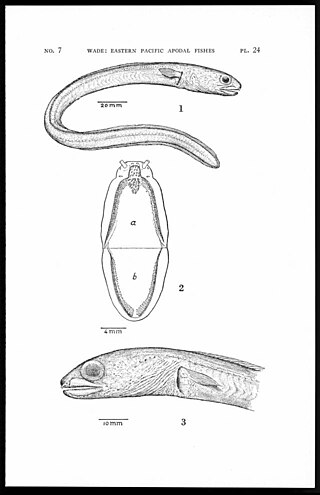
The Congridae are the family of conger and garden eels. Congers are valuable and often large food fishes, while garden eels live in colonies, all protruding from the sea floor after the manner of plants in a garden. The family includes over 220 species in 32 genera.
Bathycongrus is a genus of eels in the family Congridae.
Bathymyrus is a genus of eels in the family Congridae. It currently contains the following species:

Bathyuroconger is a genus of eels in the family Congridae. It currently contains the following species:
Blachea is a genus of eels in the family Congridae.
Chiloconger is a genus of eels in the family Congridae.

The garden eels are the subfamily Heterocongrinae in the conger eel family Congridae. The majority of the 36 known species of garden eels live in the Indo-Pacific, but can be found in warm ocean water worldwide. These small eels live in burrows on the sea floor and get their name from the behavior of poking their heads from their burrows while most of their bodies remain hidden. Since they tend to live in groups, the many eel heads "growing" from the sea floor resemble the plants in a garden. They vary in color and size depending on the species. The largest species reaches about 120 cm (47 in) in length, but most species do not surpass 60 cm (24 in). Garden eel colonies can grow as large as one acre in surface area and number up to several thousand individuals.
Japonoconger is a genus of eels in the family Congridae.
Parabathymyrus is a genus of eels in the family Congridae.

Paraconger is a genus of eels in the family Congridae. It currently contains the following species:
Promyllantor is a genus of eels in the family Congridae.

Rhynchoconger is a genus of eels in the family Congridae.
Uroconger is a genus of eels in the family Congridae. It currently contains the following species:
Gavialiceps is a genus of eels in the family Congridae, the conger eels.

The Congrinae are a subfamily of eels in the family Congridae.
Acromycter alcocki is an eel in the family Congridae. It was described by Charles Henry Gilbert and Frank Cramer in 1897, originally under the genus Promyllantor. It is a marine, deep water-dwelling eel which is known from Hawaii, in the eastern central Pacific Ocean. It dwells at a depth range of 388–640 metres. Males can reach a maximum total length of 25.3 centimetres.
Acromycter atlanticus is an eel in the family Congridae. It was described by David G. Smith in 1989. It is a marine, deep water-dwelling eel which is known from the western central Atlantic Ocean. It dwells at a depth range of 503–640 meters. Males can reach a maximum total length of 29.5 centimeters.
Acromycter nezumi is an eel in the family Congridae. It was described by Hirotoshi Asano in 1958, originally under the genus Promyllantor. It is a marine, temperate water-dwelling eel which is known from Japan, in the northwestern Pacific Ocean. Males can reach a maximum total length of 40 centimetres.
Acromycter perturbator is an eel in the family Congridae. It was described by Albert Eide Parr in 1932, originally under the genus Ariosoma. It is a marine, deep water-dwelling eel which is known from the northwestern and western central Atlantic Ocean, including the Bahamas, the United States, and Jamaica. It dwells at a depth range of 1299–1318 metres.
Paruroconger is a monospecific genus of marine ray-finned fish belonging to the subfamily Congrinae, the conger eels, in the family Congridae, which also includes the[[garden eel]s. The only species in the genus is Paruroconger drachi, an eel which is known only from the holotype collected in the Eastern Atlantic Ocean off Pointe-Noire in the Republic of Congo.





